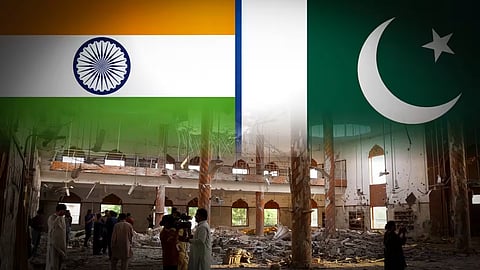

The horrific attack in Pahalgam, Kashmir, claiming the lives of 26 Indian tourists, wasn’t an isolated incident; it was a spark igniting a powder keg of historical grievances, geopolitical manoeuvring, and the terrifying prospect of nuclear conflict.
This event has once again exposed the volatile interplay between sensationalised media narratives, aggressive military posturing, and the ever-present, chilling threat of escalation to nuclear war. The current situation is no longer simply a bilateral issue between India and Pakistan but has become a complex web of regional and global interests, demanding urgent attention and a nuanced approach.
For decades, India pursued a policy of “de-hyphenation,” attempting to separate its international standing from that of Pakistan and to treat the situation in Jammu and Kashmir as an internal matter.
This strategy aimed to diminish Pakistan’s influence on India’s global image and limit international interference. However, the recent exchange of missile strikes – a direct and dangerous escalation – coupled with subsequent international interventions, has fundamentally re-hyphenated the two nations. Kashmir, dormant away from attention for years, has once again become a central focus of international concern, whether desired by all parties or not.
This return to prominence underscores the enduring and intractable nature of the dispute.
The immediate aftermath of the Pahalgam attack saw a rapid escalation of military tensions. Beyond the initial condemnation and retaliatory rhetoric, both India and Pakistan engaged in demonstrable military displays, including missile tests and heightened border security.
This wasn’t simply about demonstrating strength; it was a dangerous game of signalling, intended to deter the other side and simultaneously reassure domestic constituencies. However, such displays carry immense risk. The potential for miscalculation, stemming from inaccurate intelligence, faulty communication, or simply a misinterpretation of intent, is alarmingly high. A rash, emotional response, fueled by nationalistic fervour, could easily spiral out of control.
This is further compounded by the fact that both India and Pakistan are confirmed nuclear powers, possessing significant and growing arsenals. The doctrine of ‘Mutually Assured Destruction’ (MAD), while theoretically a deterrent, offers little comfort when faced with the realities of South Asian geopolitics.
The geographical proximity of major population centres, coupled with the potential for regional instability and the involvement of non-state actors, dramatically increases the risks associated with nuclear brinkmanship. The bellicose language employed by officials on both sides, while perhaps intended for domestic consumption, only serves to exacerbate these dangers, sending alarming signals to the international community.
The international response to the crisis was predictably fractured. China, Turkiye, and Azerbaijan offered explicit support to Pakistan, reflecting existing strategic alignments and potentially a desire to counterbalance Indian influence.
This support, while unsurprising, further complicated the diplomatic landscape. Simultaneously, Saudi Arabia, leveraging its considerable influence in the region, spearheaded Arab efforts aimed at de-escalation, recognising the potential for wider instability.
The United States, under President Donald Trump, attempted to position itself as a mediator, a move driven partly by a desire to project American leadership on the global stage. Trump’s public pronouncements, while seemingly even-handed in praising both New Delhi and Islamabad, were also strategically calculated.
He emphasised the need for dialogue and proposed US-hosted talks, led by the Secretary of State. Crucially, he also highlighted Pakistan’s past support during the Afghan conflict, a clear signal that Islamabad retains strategic value for Washington, even amidst the ongoing tensions. This acknowledgement, while pragmatic, risked being perceived as tilting the scales and further fueling Indian anxieties.
The ceasefire declared on May 10th, while a welcome development, should not be mistaken for a genuine breakthrough. It represents a temporary pause in active hostilities, a breathing space, but the underlying issues remain fundamentally unresolved.
The core grievances driving the conflict – disputed status of Kashmir, the aspirations of Kashmiris, and the historical mistrust between the two nations – continue to simmer beneath the surface, ready to erupt at any moment. The ceasefire is, at best, a fragile truce, dependent on continued restraint and a willingness to engage in meaningful dialogue.
The root of the Kashmir conundrum lies in the incomplete partition of British India in 1947, leaving a predominantly Muslim region with a Hindu ruler, leading to conflict and ultimately, a divided territory. Decades of broken promises, human rights abuses, and political manipulation have fueled resentment and armed resistance, creating a fertile ground for violence.
The media, on both sides of the border, often exacerbates these tensions, employing sensationalised reporting and nationalist rhetoric that demonise the “other” and undermine efforts towards reconciliation. Indian media houses during the current crisis were seen as spreading misinformation and looting like war rooms.
Addressing this complex situation requires a multi-faceted approach. The international community must move beyond superficial mediation and adopt a strategy based on genuine understanding, moral clarity, and a commitment to justice. This includes acknowledging the legitimate grievances of the Kashmiri people, promoting human rights, and fostering a climate of trust between India and Pakistan.
Accountability for past atrocities is paramount. The victims of the Pahalgam massacre, and the countless others who have suffered during decades of violence, deserve justice and recognition. Ignoring their plight only perpetuates the cycle of violence and fuels further resentment.
Ultimately, the question is not whether another crisis will erupt, but when. Will the world exhibit the moral courage to engage meaningfully with the root causes of disruption in South Asia, or will it once again look away, content to offer platitudes and condemnations until the next explosion shakes it from its complacency?
The clock is ticking, and the stakes – the peace and security of a region of over 1.6 billion people, and the potential for a catastrophic nuclear conflict – are simply too high to ignore. The future of South Asia, and perhaps the world, hangs precariously in the balance.
(The writer is the chairman of Kashmir Institute of International Relations (KIIR) and can be reached at: saleeemwani@hotmail.com and on X @sultan1913)
Have you liked the news article?